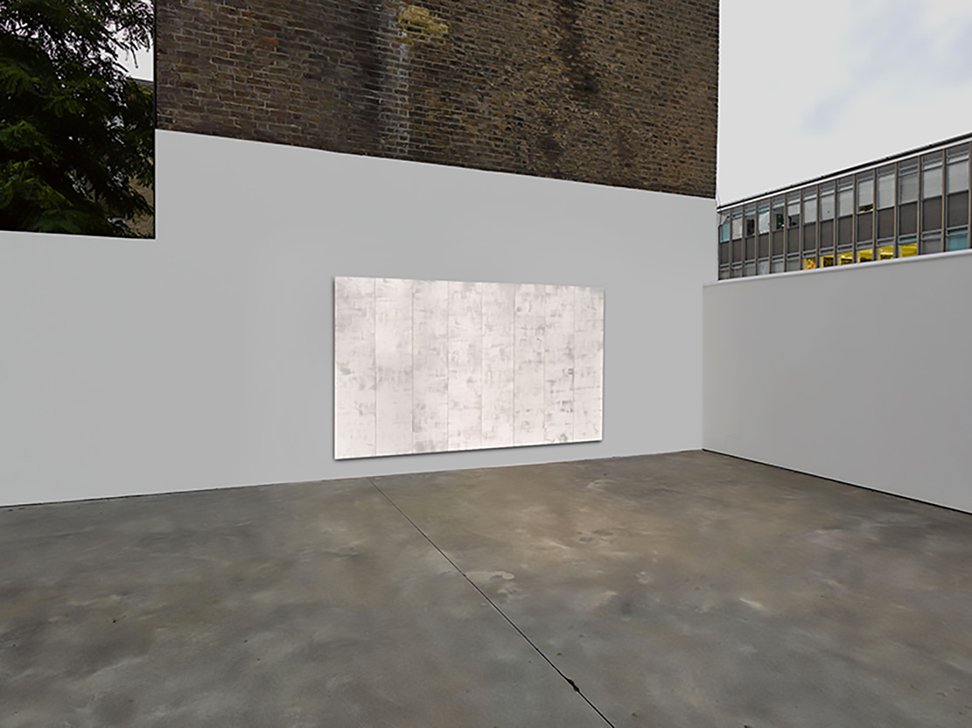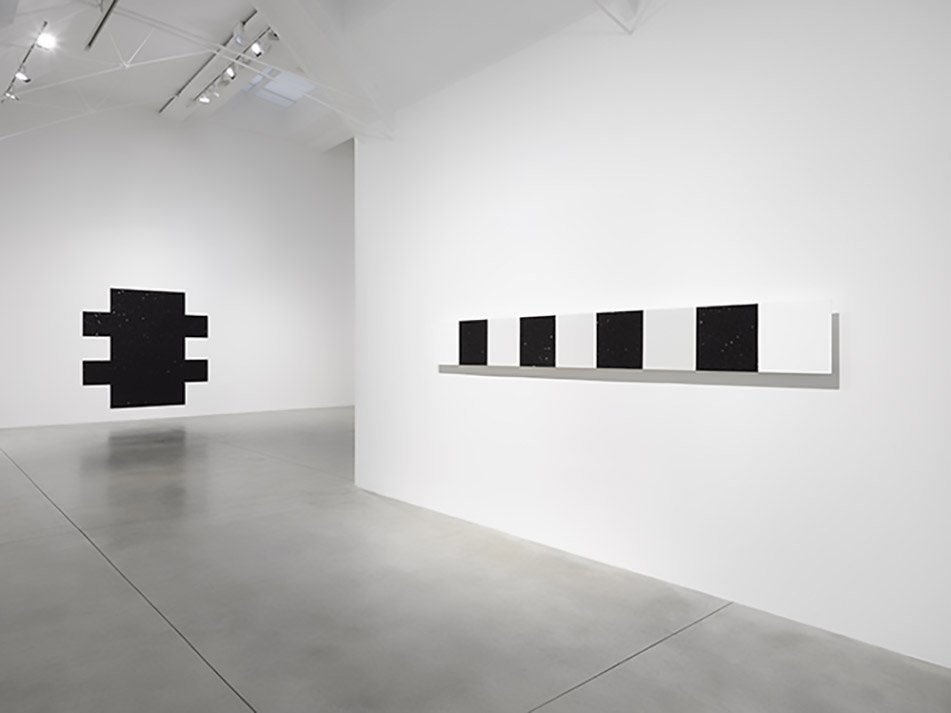The Inspiration Behind Mary Corse’s Works
Entering Lisson Gallery, one becomes immersed in the light and space that Mary Corse has created with her new series of monochromatic works. When one first encounters the art of Mary Corse, they appear to be flat, minimalist works sculpted in unyielding perfection. But with every step one takes, these seemingly implacable works come alive in a delicate dance between the movement of one’s body and the skin of the paintings.
A pioneer of light-based art, Mary Corse was one of the few women working in California’s Light and Space movement in the 1960’s, whose members included James Turrell, Robert Irwin, and Larry Bell. Paying little attention to the backdrop of the male-dominated school, Corse focused on her own mastery over the materiality of light and expanded the boundaries of painting. Interweaving minimalist painting, Abstract Expressionism, and scientific inquiry into her own language of art, Corse developed a practice that holds a unique space in art history.
© Mary Corse; Courtesy Lisson Gallery. Mary Corse: Variations Exhibition View. 27 Bell Street, Lisson Gallery, London. 6 October - 4 November 2020.
Born and raised in California, Corse expresses her deep appreciation for its climate and its beautifully expansive sky, but maintains her works have nothing to do with the landscape, or even the sunlight that surrounds her. Corse’s works are rooted in abstraction and her internal world. ‘We live in abstraction. You don’t see the other side of the moon. You don’t see the room behind you. But they’re still there,’ she says. She studied Willem de Kooning, Hans Hofmann and Josef Albers, and developed her own language of art. Her paintings are an expression of the human perception of objects, rather than a rendering of the object itself. With a paint brush in her hand, Corse immediately becomes immersed in a world that eclipses daily musings and judgments. ‘The act of painting has the ability to transcend your moment and put you in a different sphere. In painting, I find infinite conversation instead of finite thinking,’ she says. The resulting works engage the viewer in an open-ended conversation with abstraction. They look different to each individual, from moment to moment, from one angle to another. Even cosmic forces such as light, space, and time are felt and experienced differently by every individual. Her paintings awaken the viewer’s consciousness, sparking a deeper connection with the external world and with one’s own soul.
In the 1960’s, Corse graduated from Chouinard Art Institute (now CalArts), and she also began making a series of electric light boxes that radiated with white light. These ethereal light boxes floated freely on the wall like a painting, standing alone without a tangle of cords. Corse’s light boxes exemplify her pioneering spirit and her scientific rigour. She had to take a course and pass a test in quantum physics in order to obtain the materials to make her own high-frequency-generating Tesla coils which wirelessly powered her light boxes. She now reflects how much these classes changed her perception of reality—they reminded her that there was no objective truth in the human experience. This realisation prompted Corse to want to find a way to put light in her paintings. She sought to move away from direct electric light, and instead find a way to illuminate her paintings from within. Corse’s consequent discovery and innovative embodiment of light in her paintings changed the course of art history.
“The work comes from an inner vision, an inner light. For me, art is about connecting with your inward self, your true self, your soul, a place inside.”
Finding a way to put light into her paintings, she experimented with different materials, from Murano paint to materials that glowed in the dark. But the lightbulb went off when she was driving home from Malibu one evening. Seeing the white dividing lines on the road light up in the dark, she thought, ‘Oh, let’s try that.’ Corse started blending glass microspheres with acrylic paint, giving birth to the ‘White Light paintings’ that would define her oeuvre for the next five decades. The glass microspheres act as tiny prisms, refracting light into countless rays which emanate from her luminous canvases. She explains that a microsphere creates a triangle between the surface, the viewer, and the light source, so ‘as you move, the painting changes. Therefore, it puts the painting into your perception, rather than on the wall.’ Corse’s works physically interact with the viewer, inviting the viewer’s gaze and movement to complete the painting. Subjective experience is imperative to Corse’s oeuvre—her scintillating canvas reflects light differently at every angle, and the result entirely depends on the viewer’s perception and position in relation to the work. The painting changes as the viewer moves around it, rendering a dazzling effect akin to the way sunlight shimmers on rippling waves.
While her vocabulary of forms has changed over the years, all of Corse’s works relate to one another in a continuous conversation. All of the works at her recent show in London at Lisson Gallery were completed in 2020, yet all of these new works reference the different series and variations of styles she developed throughout her five-decade career. Untitled (White and Black Reflective Inner Bands) 2020 exhibits her two signature techniques side by side. The painting has glass microspheres on the white bands and black acrylic squares on the black bands. ‘Each of these materials brings the viewer into the painting,’ she says. They create a flow which streams from the light source, to the surface of the painting, back to the viewer.
© Mary Corse; Courtesy Lisson Gallery. Mary Corse: Variations Exhibition View. 27 Bell Street, Lisson Gallery, London. 6 October - 4 November 2020.
Corse first began to use black acrylic squares in the 1970s, but she has recently re-introduced them in her ‘DNA Series’ in 2017, as well as in her ‘Double Cross’ paintings at Lisson Gallery. The cross, too, has appeared in a cyclical nature in Corse’s works throughout the decades, with roots in a significant work from 1975, Untitled (Black Light Painting, Glitter Series). Now the artist expands on her vocabulary of forms by carving thin metal sheets into a variation of crosses, and the resulting shaped canvases seem to emerge from the white wall to invite the viewer into an otherworldly sphere. With black acrylic squares that twinkle like stars on the canvas of a night sky, the Double Cross resembles a window or portal into the infinite cosmos.
Challenging the notion that paintings are flat surfaces, Corse uses materials such as reflective acrylic squares, shimmering glass microspheres, and shaped canvases to make her paintings three-dimensional objects. Her practice unveils her deep understanding of human perception, light, and quantum physics. The ethereal inner glow of her minimalist paintings seem to be lighted from within, awakening one’s consciousness of one’s body in space. When one walks by her painting, ‘it brings time in. As you move, the painting changes. Someone at the other end sees something different than you do. You become conscious of perception making the painting,’ she says. The ephemeral, experiential nature of Corse’s works reveal the infinite variability of perception: each individual sees and experiences life differently. Sheen swathes of brushstrokes reveal the artist’s hand, adding another dimension of subjectivity to Corse’s cosmic art, which addresses the exterior universe as well as the interior world of the artist. Corse’s spiritual and meditative bodies of work compel us all to reconsider the power of perception. They heighten the connection between our senses and illuminate the experience of being alive.
“The art is not on the wall, it’s in the viewer’s perception.”
© Mary Corse. The outside of Mary Corse’s studio in Topanga, CA, USA. Untitled (White Light Inner Band), 2016. Glass microspheres and acrylic on metal. 15 x 60 ft.
‘Painting, to me, has never been about the paint, but what the painting can make you feel.’ While Mary Corse has had a rich five-decade career, and has contributed much to the Light and Space movement, she is only now receiving considerable attention due to the industry’s focus on male artists until recent years. However, Corse’s presentation at Lisson Gallery reveals how she never stopped creating in her remarkably unique style, consistently expanding on her variations through history, from the 1960’s to 2020. And thus, she is now receiving much-deserved recognition for her sensational works. In 2018, she had a solo exhibition at the Whitney Museum of American Art in June that travelled to the Los Angeles County Museum of Art—a beautiful survey which consisted of more than two dozen works from the past 54 years. Earlier that year, she also showed at Lisson Gallery and Dia:Beacon. Today, Corse continues to make phenomenal works in her studio tucked away in the hilltop of Topanga Canyon, California. She is a role model and inspiration for so many of us, and when asked what advice she would give to an artist at the start of her career, the simple words ‘you have to just do it’ reflect her independent, pioneering, do-it-yourself spirit that lighted the way her entire career.



